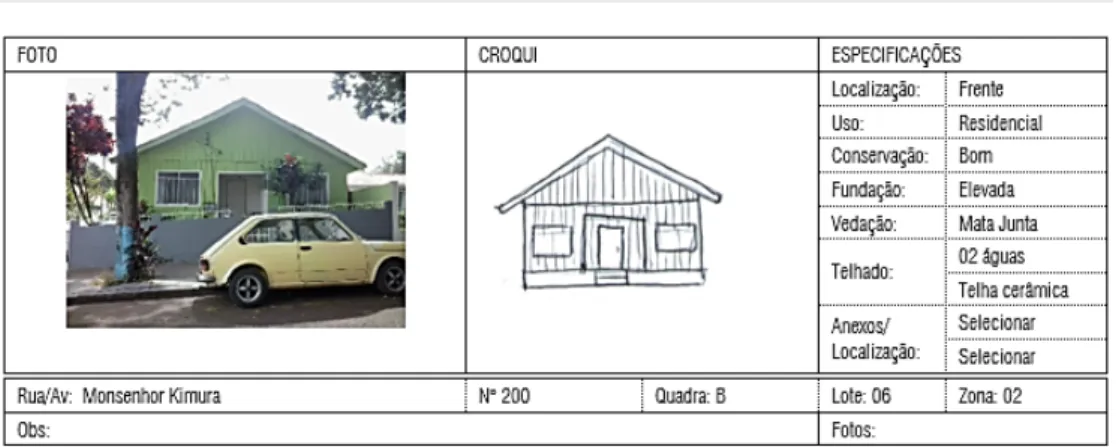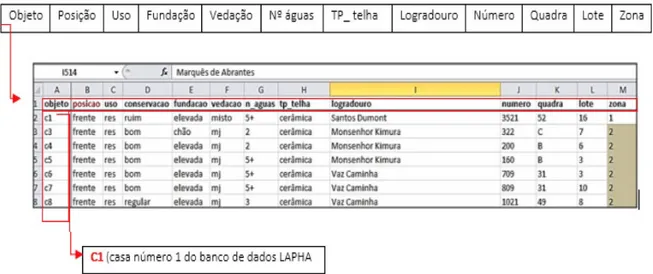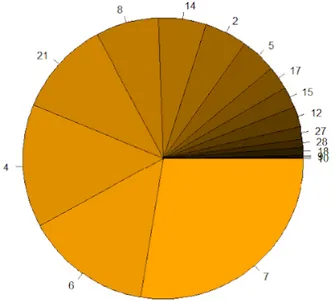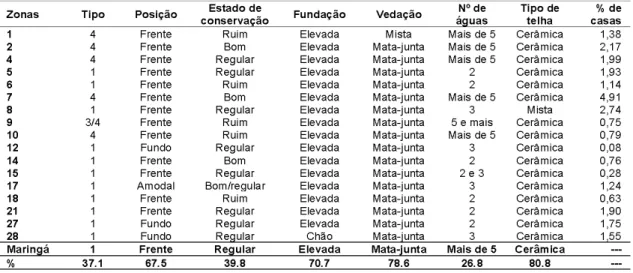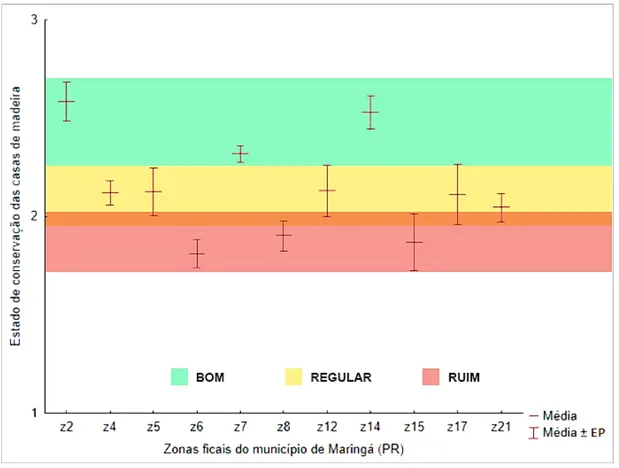IOP Conference Series: Materials Science and Engineering
PAPER • OPEN ACCESS
Traditional wooden houses in Maringá (Brazil): ICT in planning research
To cite this article: Camila Nakamura-Gonino et al 2019 IOP Conf. Ser.: Mater. Sci. Eng. 603 022023
View the article online for updates and enhancements.
WMCAUS 2019
IOP Conf. Series: Materials Science and Engineering 603 (2019) 022023
IOP Publishing doi:10.1088/1757-899X/603/2/022023
Traditional wooden houses in Maringá (Brazil): ICT in
planning research
Camila Nakamura-Gonino1, Ana Virtudes2, Ricardo Silva3
1Master Degree in Architecture and Urbanism, State University of Maringá (UEM), Paraná, Brazil
2C-MADE Centre of Materials and Building Technologies, University of Beira Interior, Covilhã, Portugal
3State University of Maringá, PPU/Post-Graduation Program in Architecture and Urbanism, Campus Universitário Maringá, Brazil
virtudes@ubi.pt
Abstract. In many cities, the examples of traditional architecture are being replaced by
contemporary buildings, without any strategies in order to preserve a specific period of the urban and housing histories. These legacies are witnesses of particular features in terms of local communities, societies, political environments, urban morphologies or architectural languages. In this sense, this article presents the case study of the traditional wooden houses in the city of Maringá in Paraná (Brazil). There is a set of buildings which still remain among the existing urban fabric. However, every year some of them are destroyed in order to give room for new ways of designing the city. The methodological approach is based on the ICT (information and communication technologies) as a tool to study the features of these traditional wooden buildings.
1. Introduction
The accelerated processes of urban renewal drive the disappearance of important examples of popular architecture in contemporary cities. This architecture is able to manifest material ways of creating, doing and living of the common man and the context in which it is inserted.
The city is a space made up of overlaps of times, histories and manifestations. Alongside the other types of buildings, popular architecture is part of the narrative of the economic, social, and spatial transformations that have occurred over time. The technological tools are mainly focused on diagnostics and data collection for the execution of reactive actions of architectural conservation despite the
WMCAUS 2019
IOP Conf. Series: Materials Science and Engineering 603 (2019) 022023
IOP Publishing doi:10.1088/1757-899X/603/2/022023
2
2. Method for recognizing and analyzing trends of the set of popular wooden houses
The proposed method in this research is based on the evaluation of the architectural characteristics of the wooden houses and the analysis of trends of the set of houses from the state of conservation of this. The database used was constructed by the Research Laboratory on Housing and Human Settlements (LAPHA) of the State University of Maringá, Paraná, Brazil.
According to LAPHA [1], all existing wooden houses in the urban perimeter visited in loco were registered. These houses were listed in a database divided into two construction periods, 1940-1960s and 1960-1970s, established on the occupation date of the tax zones that divide the city. The main architectural features of the registered wooden houses were the residential use, the use of the board and mata-junta system, ceramic tiles and raised foundation.
Despite providing important information for the development of research about the wooden popular architecture in the city, the data obtained had not undergone any kind of analysis or more in-depth organization. Based on this fact, this research established a method for systematization and analysis of this material with the support of different software.
2.1. Data systematization
The LAPHA data (Figure 1) were formally rearranged in a Microsoft Excel® spreadsheet (Figure 2), containing the variables: street, number, block, location, use, conservation, type of foundation, number of waters of the cover, type of tile, existence and location of the annexes.
Figure 1. Database pattern from LAPHA, 2016, Maringá (Brazil)
The house location, use, foundation type, sealing system, and coverage characteristics were conserved variables in the new database reformulated in a spreadsheet (Figure 2). However, variables, related to the presence and location of annexes, were excluded because they were not directly significant for the proposed objectives. To these data were added those corresponding to the typological classification of house proposed by Nakamura-Gonino [2] in her dissertation of master degree.
WMCAUS 2019
IOP Conf. Series: Materials Science and Engineering 603 (2019) 022023
IOP Publishing doi:10.1088/1757-899X/603/2/022023
Figure 2. Reformulated spreadsheet, Maringá (Brazil) 2.2. Statistical analysis
A statistical analysis of all household characteristics, qualitative and quantitative variables was carried out in order to obtain information about the dynamics and general characteristics of the set of remaining wooden houses in Maringá. The measure of central tendency, known as mode, was obtained from the qualitative variables. Statistical analysis made it possible to identify the most frequent typology, which zone and street have more wooden houses, or which zone has more conserved houses, and which architectonic features appear in the studied set of houses.
2.2.1. Statistical analysis of the variable Conservation state. The statistical analysis of the categorical variable "conservation state" was performed to identify the area with the most houses conserved in the city. The mode for the conservation state was REGULAR (391 houses), using the classification proposed by LAPHA. We assign several values to the conservation state (1 = bad, 2 = regular and 3 = good) and transform this categorical variable into numeric (Table 1). In this way, it was possible to perform statistical tests of meaningful analysis. The Kruskal-Wallis non-parametric test was used since the assumptions of normality and equality of variances were not accepted after verification with the Shapiro-Wilk and Levene tests. All statistical analyses were performed using the R software [3].
Table 1. Assignment of numeric categories to the conservation state variable for meaningful analysis, Maringá (Brazil)
Conservation state Numeric Number of houses
Good 3 356
WMCAUS 2019
IOP Conf. Series: Materials Science and Engineering 603 (2019) 022023
IOP Publishing doi:10.1088/1757-899X/603/2/022023
4
proportionally the frequency of wooden houses in the Maringá areas. The upper right of the graph where it is not possible to clearly identify the zone numbers indicates that in these areas the number of houses is not significant. The non-significant percentages can be queried later in table 3.
Figure 3. Graph of the requency of wooden houses in the fiscal zones of Maringá (Brazil) The lowest densities of wooden houses were found in zones 1, 9, 10 and 18, all with less than 1% of the sample. The street with the highest density of wooden houses was Rui Barbosa Street, with 39 houses (3.97%), followed by Princesa Isabel (3.26%), Osvaldo Cruz (2.75%) and Marquês de Abrantes (2.34%), all in Zone 7, Rua Machado de Assis (2.85%) and Castro Alves (2.14%) in zone 6, and Jalbas Rodrigues Alves Street (2.44%), Zone 21.
The most frequent types (typology) were 1 (the mode of wooden houses in Maringá) and 4, accounting for more than 60% of houses.
Table 2 was obtained from the analysis of the descriptive statistics and shows that the mode for the position, foundation, fence and tile type did not have significant variation, following the trend of the entire population, while typology, conservation, and the number of waters presented greater diversity in the data set.
In addition to the holistic analysis of the city, an analysis was carried out by areas of the city of Maringá. Zones 1, 9 and 10 were not analyzed because they did not present a significant number of houses.
WMCAUS 2019
IOP Conf. Series: Materials Science and Engineering 603 (2019) 022023
IOP Publishing doi:10.1088/1757-899X/603/2/022023
Table 2. Mode of the categorical variables related to the wooden houses in the fiscal zones of Maringá (Brazil)
Zones 4, 6, 8, 7, 12, 14, 15 and 21 presented all the 6 proposed types, being considered more diverse zones in the popular wood architecture, while zones 18 and 28 presented only 3 types, type 1 common to both. Figure 4 shows the percentage of each type in each zone ordered in ascending order by the number of houses. In addition to presenting the variations between the zones, the figure allows the visualization of the variations between the architectural types within the same zone.
WMCAUS 2019
IOP Conf. Series: Materials Science and Engineering 603 (2019) 022023
IOP Publishing doi:10.1088/1757-899X/603/2/022023
6
The distribution analysis shows that some areas have more wooden houses than others. The zones with the highest absolute frequencies can be explained, in part, by their size, since the highest densities of houses occurred in the larger zones or that presented areas above 1 km2 [4]. That is, the larger the area, the greater the chance of finding the wooden houses. The denser areas remain with their residential function to this day. However, the areas with the lowest densities of wood residences found (ie 1, 9, 10 and 18) currently concentrate commercial activities, as they are distributed along one of the main thoroughfares of the city, Colombo Avenue, an "urban highway".
In addition, it is believed that the distribution found is due to the imposition of prohibitive laws for the construction of wooden houses in the central area, as well as real estate speculation, since the denser areas are outside the central and commercial area. The areas with the most absolute frequency of wooden houses follow the trend of distribution by zones, with more wooden houses in streets located in areas with more wooden houses.
We believe that the establishment of legislation to prevent the wooden buildings and the needs of real estate speculation is related to the distribution of the set of houses throughout the city. That is why Zone 1 presents one of the smallest percentages of the total number of wooden houses raised in the city compared to other areas since the wooden buildings were prohibited by Decree Law 34/59 [5] and there is great real interest for commercial activities.
As for the architectural types identified according to Nakamura-Gonino [2], the statistical analyses indicate that the majority of houses surveyed are type 1 and 4, although all the zones present all proposed typology. This result may indicate that the pioneers opted for less complex architectural types because of time and investment, through the urgency of installation. Or that the local carpenters were more accustomed to working with these two types.
The Conservation State Average (MEC) of the wooden houses divided the dataset into three distinct groups, representing the three classes of this variable. The zones with higher MEC are clearly separated from the other two groups (Figure 5). The variance analysis of the MEC, using the Kruskal-Wallis statistical test, indicated a significant difference (p <0.05) between the conservation status of the houses in different fiscal zones of Maringá.
It was observed that the mean of zone 2 (MEC = 2.583) differed significantly from all other zones studied, except for zone 14 (MEC = 2.529), whose highest mean was similar. Despite being located in the upper portion of the graph, zone 7 (MEC = 2.318) differed significantly from zone 2, more conserved, so it was chosen to place it in the intermediate zone. Thus, zones 4, 5, 7, 12, 17 and 21 make up the intermediate group, whose MEC reflects greater proximity to the regular situation (MEC equal to 2.121, 2.125, 2.318, 2.130, 2.111 and 2.047, respectively). Zones that represent the MEC closest to the bad situation, is not as prominent as the first and is represented by zones 15 (MEC = 1,870), 8 (1,901) and especially zone 6 (1,812). This last one was the only area of the lower group that presented significant difference with zones of the intermediate group. The Spearman correlation index between foundation and conservation, even with p> 0.05, decreased between houses with a raised foundation to the good, regular and bad conservation state, respectively.
WMCAUS 2019
IOP Conf. Series: Materials Science and Engineering 603 (2019) 022023
IOP Publishing doi:10.1088/1757-899X/603/2/022023
Figure 5. Analysis of the average of conservation state of the wooden houses in the fiscal zones of Maringá (Brazil)
Thus, there is statistical evidence of one or more factors that influence the difference in conservation status among the wooden houses in the different areas of Maringá. Although most wooden houses have been classified with good or regular conservation status, there are areas with significant differences from others. This is the case of Zone 2, clearly the area with the best preserved wooden houses in Maringá. In sum, it is mathematically proven that zone 2 presents some characteristic that justifies the occurrence of a smaller number of houses with poor conservation status in relation to the other zones. We believe that this characteristic is the socio-economic level of the inhabitants of this zone, the biggest of all the others.
4. Conclusions
The methodology proposed in this research made it possible to obtain results regarding the interaction of the set of wooden houses with the rest of the city. From a more proactive perspective, it enabled the identification of elements and relationships, both architectural and urban, to be considered in the preservation strategies. It is clear that the institution of actions to safeguard the popular architecture
WMCAUS 2019
IOP Conf. Series: Materials Science and Engineering 603 (2019) 022023
IOP Publishing doi:10.1088/1757-899X/603/2/022023
8
Acknowledgment(s)
This work is supported by Portuguese national funds by FCT - Foundation for Science and Technology within the UID/ECI/04082/2019 project.
References
[1] State University of Maringá. Laboratory for Research in Housing and Human Settlements - LAPHA.
[2] C. Nakamura-Gonino. Classification and Characterization of the remaining wooden houses in Maringá, PR (1940 -1960). Thesis (Master degree in Architecture and Urbanism) - Faculty of Architecture and Urbanism, State University of Maringá. Maringá, p. 145. 2018.
[3] R Core Team, A language and environment for statistical computing. R Foundation for Statistical Computing. Vienna, Austria. [Online] 2017 [Accessed 22. 03. 2019] Available at: <http://www.R-project.org>.
[4] MARINGÁ. Geoproc Maringá. [Online] 2018 [Accessed 22. 03. 2019] Available at: <http://geoproc.maringa.pr.gov.br>.
[5] MARINGÁ (councilmen’s homes). Law nº 34/59 de 31 october, 1959. Lex: Código de Posturas e Obras de Maringá, Maringá, 1959.
